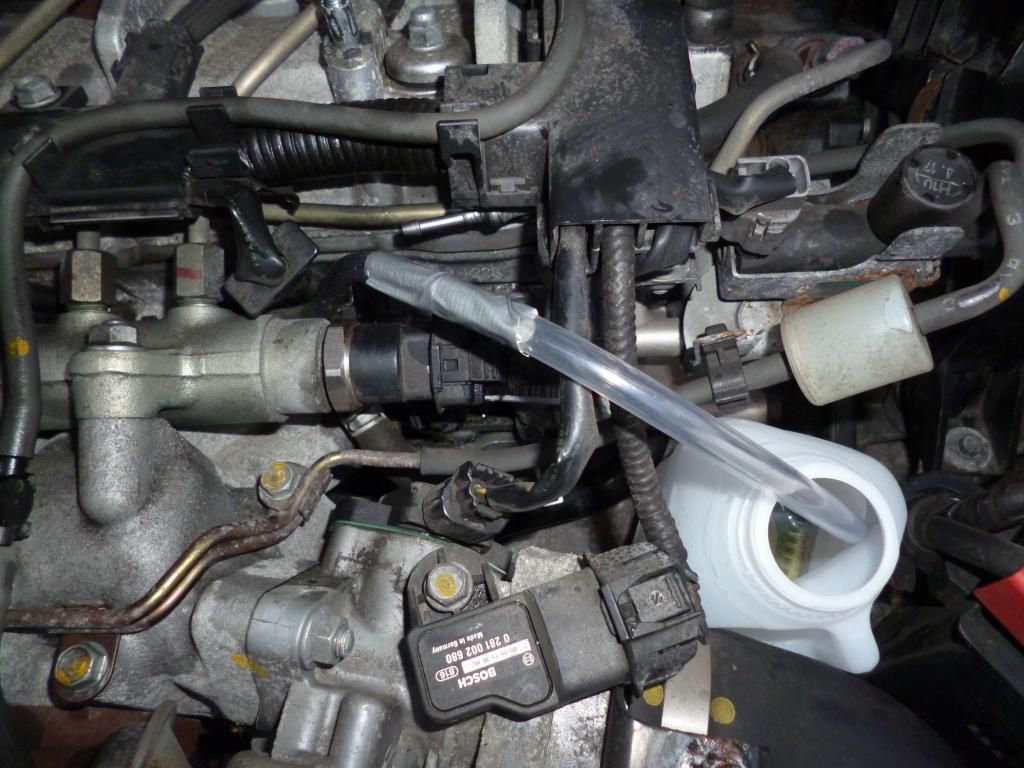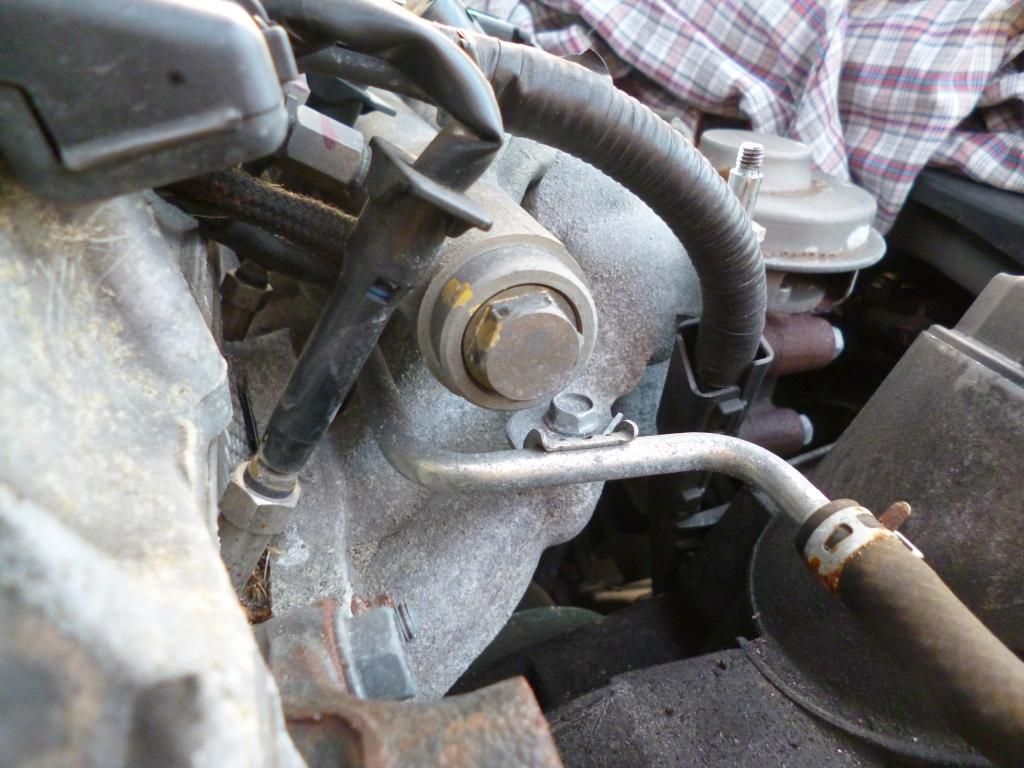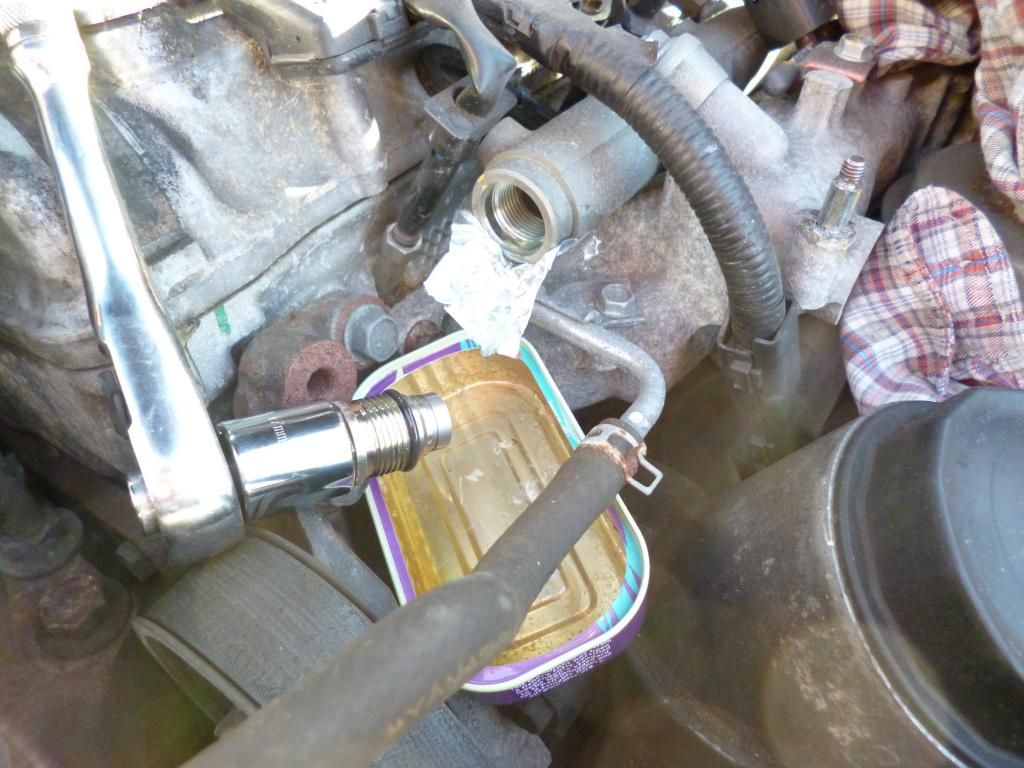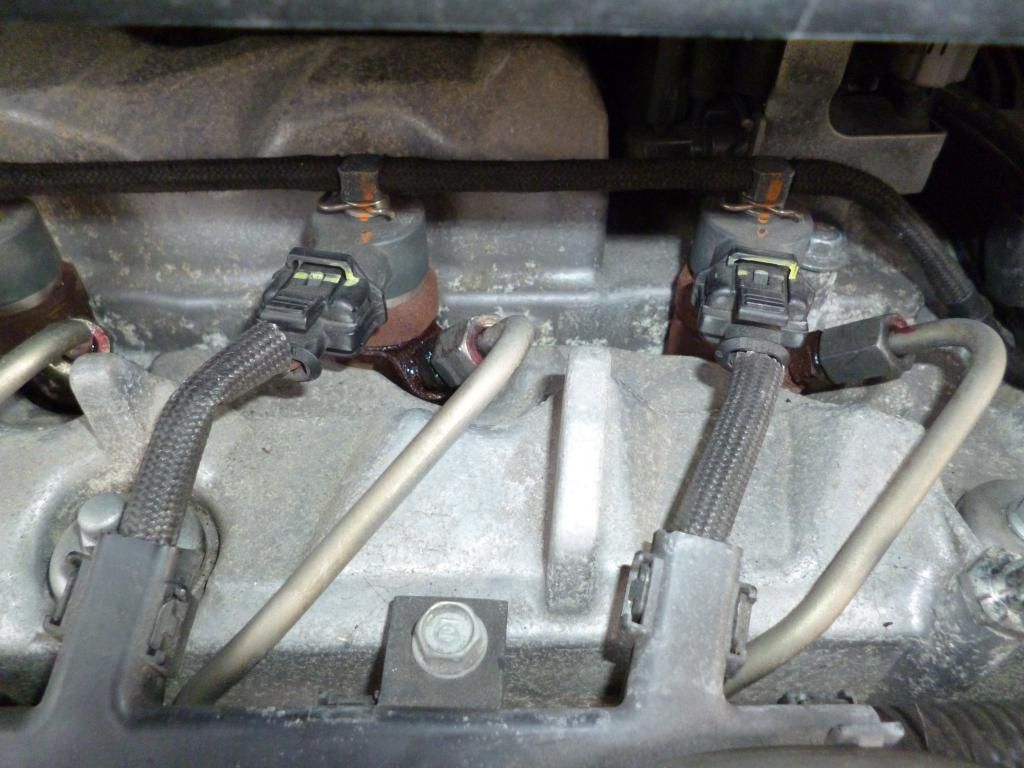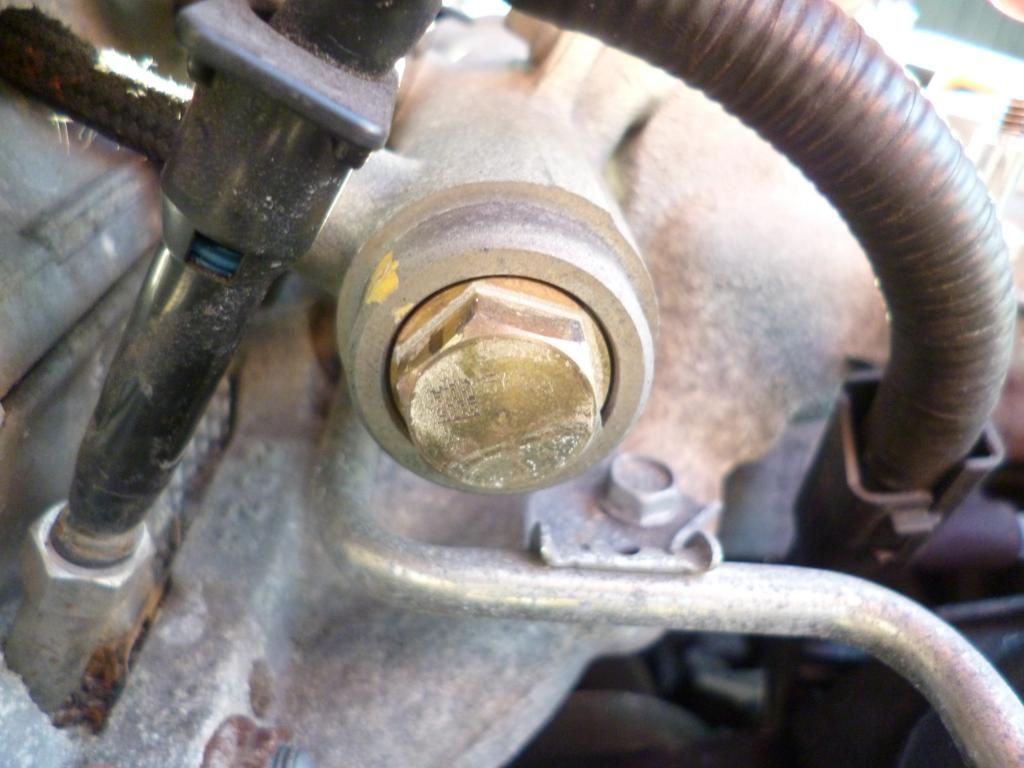As promised, a how to guide on how to diagnose a replace the over pressure relief valve on an 2006 2.2 I-CTDi engine. My thanks goes to Jon_G for his advice on the diagnosis and valve replacement. You follow this guide at your own risk. If you're not confident then please appoint a garage. Where I use the phrase bolt/valve I mean the over pressure relief valve.
Symptoms;
Hard starting when the engine has warmed through and is encountered in the early days of the fault, possibly first noticed when the engine has had to be restarted soon after a journey. In the early days of the fault the car starts fine when stone cold and if immediately switched off it restarts again, this can be done several times and is okay. It's only when the engine has been warmed through that the hard engine starting trouble emerges. The longer the engine has been left from last use the engine will fire up more easily; after 15mins-30mins engine will not start, struggles to fire up after 1hr, more easily after 2hrs. Apparently this may have something to do with the viscosity of the diesel when warm as it is then more likely to leak past the faulty relief valve.
I noticed just before I changed the valve that the problem was beginning to happen with the engine from cold.
No symptoms encountered when driving, just don't stall that diesel engine!
Tools for diagnosis; pilers, pvc tubing, a container, adhesive tape and rags.
Look at the engine. The fuel rail is the tube with several brass nuts with narrow metal tubes (fuel lines) attached. To the left hand end of the tube, easily missed, is what appears to be a 17mm bolt. Close by is a black braided flexible tubing (low pressure fuel return pipe).
With the engine off, disconnect/pull off the black braided hose, you may need a flat bladed screwdriver to get this started. Attach PVC tubing to the end of the braided tube, seal with adhesive tape, put other end of PVC tubing into container. A 1pt milk bottle seemed to rest quite neatly in the engine bay. Place rages under the tubing and the now exposed metal tube.
Turn over the engine for about 10-15seconds. Return to the engine bay and inspect the container. If diesel is present either in the tube or in the container the over pressure relief valve is most likely to be faulty. See photo.
![Image]()
Congratulations, you may now decide if you want to replace the over pressure relief valve yourself or give the work to a local garage to do. The single most important consideration for a DIYer is being able to undoing that 17mm bolt/valve. It is seriously tight.
This is the bolt/valve
![Image]()
To get the bolt/valve off I used a 1/2" 75cm breaker bar and 17mm socket. The bar was placed on the crook of my right shoulder, my left hand was supporting the 17mm socket to keep this as true as possible on the bolt to avoid round the hex bolt corners. I then lifted using my leg muscles. The engine rolls about a bit when you lift. I nearly gave up but on the final attempt the bolt broke (loud bang). I checked the fuel rail mountings as I was worried these had snapped the base of the threaded mounting studs through leverage action while undoing the bolt/valve.
The valve is a Bosch part at ~£150. Note the fuel rail number eg xxx-RGB-xxxxx. A common number on the part found on the old and new valve was F166. On the part receipt it was called a "pressure limiting valve" p/n F00R001166. Use this information at your own risk.
Unscrew the bolt/valve but before complete removal place something that will guide the diesel from inside the fuel rail into a container. I used foil tape to force the flow/drip into a waiting empty sardine tray which proved satisfactory. If you don't use the tape to direct the flow the diesel will spill over the engine. Initially I was concerned that on removal the bolt/valve would be under positive pressure but figuring the over pressure valve was leaking the pressure would have dissipated enough. I wore safety glasses just in case of a squirt or splash.
![Image]()
I compared the new and old part and these were no obvious differences of the old compared to the new. I also marked the new bolt/valve so I knew roughly how far I had to tighten the bolt/valve. This was done my matching the thread.
![Image]()
To the left, old over pressure relief valve, you can see the extent of the forces applied in some rounding of the hex bolt corners.
Install the new over pressure relief valve making sure the new o-ring (supplied) is installed. I did not used thread lock. Initially I tightened this up by hand, then gently turned using a ratchet until it could go no furhter, then with the breaker bar turned approximately 1/16th to 1/8th of a turn which was where the new marking on the bolt/valve lined up with the original yellow temper/movement mark on the fuel rail. I used my torque meter after tightening but all I can say is that it was over 80Nm which was the upper limit of my 3/8" torque metre. It needs to be tight due to the pressures inside the fuel rail. I understand the bolt/valve has to withstand pressures reaching 1600psi, if the bolt/valve is loose it will fly out like a bullet.
![Image]()
Job nearly done. At this point you can choose to fire up the engine or you can bleed the fuel lines at the fuel injectors.
I decided to bleed the fuel lines. For this you need to disconnect the electronics to each injector to allow the spanner greater access to turn the nuts as otherwise this can be very tricky. I then wrapped rags around the nuts, reconnected the electronics to the injectors and turned the engine over for a short while and then stopped. After removing the rags you can see the diesel weeping. Tighten up the nuts to the fuel line to the injector. Wipe up excess diesel, if any.
![Image]()
Car should now start, maybe taking longer than usual as there could still be a little air in the fuel lines.
Idle for a few minutes. Check the bolt/valve marking for any bolt movement. Take for a test drive until the engine is thoroughly warmed through and return home. Recheck bolt/valve for any bolt movement, switch off.
Engine should restart with no hesitation
The job shouldn't take you long.
Undoing that bolt is the hardest part and possibly the only thing that could defeat the DIYer.
Hope people find this useful.
Symptoms;
Hard starting when the engine has warmed through and is encountered in the early days of the fault, possibly first noticed when the engine has had to be restarted soon after a journey. In the early days of the fault the car starts fine when stone cold and if immediately switched off it restarts again, this can be done several times and is okay. It's only when the engine has been warmed through that the hard engine starting trouble emerges. The longer the engine has been left from last use the engine will fire up more easily; after 15mins-30mins engine will not start, struggles to fire up after 1hr, more easily after 2hrs. Apparently this may have something to do with the viscosity of the diesel when warm as it is then more likely to leak past the faulty relief valve.
I noticed just before I changed the valve that the problem was beginning to happen with the engine from cold.
No symptoms encountered when driving, just don't stall that diesel engine!
Tools for diagnosis; pilers, pvc tubing, a container, adhesive tape and rags.
Look at the engine. The fuel rail is the tube with several brass nuts with narrow metal tubes (fuel lines) attached. To the left hand end of the tube, easily missed, is what appears to be a 17mm bolt. Close by is a black braided flexible tubing (low pressure fuel return pipe).
With the engine off, disconnect/pull off the black braided hose, you may need a flat bladed screwdriver to get this started. Attach PVC tubing to the end of the braided tube, seal with adhesive tape, put other end of PVC tubing into container. A 1pt milk bottle seemed to rest quite neatly in the engine bay. Place rages under the tubing and the now exposed metal tube.
Turn over the engine for about 10-15seconds. Return to the engine bay and inspect the container. If diesel is present either in the tube or in the container the over pressure relief valve is most likely to be faulty. See photo.
Congratulations, you may now decide if you want to replace the over pressure relief valve yourself or give the work to a local garage to do. The single most important consideration for a DIYer is being able to undoing that 17mm bolt/valve. It is seriously tight.
This is the bolt/valve
To get the bolt/valve off I used a 1/2" 75cm breaker bar and 17mm socket. The bar was placed on the crook of my right shoulder, my left hand was supporting the 17mm socket to keep this as true as possible on the bolt to avoid round the hex bolt corners. I then lifted using my leg muscles. The engine rolls about a bit when you lift. I nearly gave up but on the final attempt the bolt broke (loud bang). I checked the fuel rail mountings as I was worried these had snapped the base of the threaded mounting studs through leverage action while undoing the bolt/valve.
The valve is a Bosch part at ~£150. Note the fuel rail number eg xxx-RGB-xxxxx. A common number on the part found on the old and new valve was F166. On the part receipt it was called a "pressure limiting valve" p/n F00R001166. Use this information at your own risk.
Unscrew the bolt/valve but before complete removal place something that will guide the diesel from inside the fuel rail into a container. I used foil tape to force the flow/drip into a waiting empty sardine tray which proved satisfactory. If you don't use the tape to direct the flow the diesel will spill over the engine. Initially I was concerned that on removal the bolt/valve would be under positive pressure but figuring the over pressure valve was leaking the pressure would have dissipated enough. I wore safety glasses just in case of a squirt or splash.
I compared the new and old part and these were no obvious differences of the old compared to the new. I also marked the new bolt/valve so I knew roughly how far I had to tighten the bolt/valve. This was done my matching the thread.

To the left, old over pressure relief valve, you can see the extent of the forces applied in some rounding of the hex bolt corners.
Install the new over pressure relief valve making sure the new o-ring (supplied) is installed. I did not used thread lock. Initially I tightened this up by hand, then gently turned using a ratchet until it could go no furhter, then with the breaker bar turned approximately 1/16th to 1/8th of a turn which was where the new marking on the bolt/valve lined up with the original yellow temper/movement mark on the fuel rail. I used my torque meter after tightening but all I can say is that it was over 80Nm which was the upper limit of my 3/8" torque metre. It needs to be tight due to the pressures inside the fuel rail. I understand the bolt/valve has to withstand pressures reaching 1600psi, if the bolt/valve is loose it will fly out like a bullet.
Job nearly done. At this point you can choose to fire up the engine or you can bleed the fuel lines at the fuel injectors.
I decided to bleed the fuel lines. For this you need to disconnect the electronics to each injector to allow the spanner greater access to turn the nuts as otherwise this can be very tricky. I then wrapped rags around the nuts, reconnected the electronics to the injectors and turned the engine over for a short while and then stopped. After removing the rags you can see the diesel weeping. Tighten up the nuts to the fuel line to the injector. Wipe up excess diesel, if any.
Car should now start, maybe taking longer than usual as there could still be a little air in the fuel lines.
Idle for a few minutes. Check the bolt/valve marking for any bolt movement. Take for a test drive until the engine is thoroughly warmed through and return home. Recheck bolt/valve for any bolt movement, switch off.
Engine should restart with no hesitation
The job shouldn't take you long.
Undoing that bolt is the hardest part and possibly the only thing that could defeat the DIYer.
Hope people find this useful.


